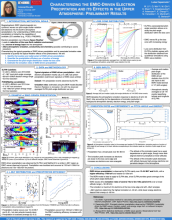Characterizing the EMIC-driven Electron Precipitation and its Effects in the Upper Atmosphere
Luisa
Capannolo
Boston University
Poster
Plasma waves can be excited in the near-Earth environment and interact with energetic electrons populating the Earth’s radiation belts. Through wave-particle interactions, electrons can be pushed into the loss cone and be lost into the Earth’s atmosphere (electron precipitation), where they deposit their energy. Electron flux variations in the radiation belt environment and the atmospheric impact of particle precipitation are important for predicting and mitigating space weather. Charged particles in the radiation belts can potentially damage satellite electronics or instrumentation leading to anomalies or failures, whereas precipitating electrons enhance ionospheric conductance and indirectly facilitate ozone reduction in the atmosphere. Therefore, it is crucial to characterize the wave-driven electron precipitation and its effects in the upper atmosphere. Here, we focus on precipitation driven by Electromagnetic Ion Cyclotron (EMIC) waves and we analyze it with high energy and pitch-angle resolution using the ELFIN CubeSats, orbiting at ~450 km. Our analysis shows that precipitation is latitudinally localized, most efficient for ~MeV electrons and accompanied by weaker low-energy precipitation down to ~100–200 keV. We also find that the loss cone is filled up with increasing energy and pitch-angle, and overall agrees with quasilinear theory predictions. Finally, we model the atmospheric ionization rates due to EMIC-driven precipitation using the BERI (Boulder Electron Radiation to Ionization) model. We show that the peak of ionization depends on the energy and pitch-angle distribution of precipitating electrons and on average occurs at ~50-60 km.

Poster PDF
Poster category
Geospace/Magnetosphere Research and Applications
Meeting homepage